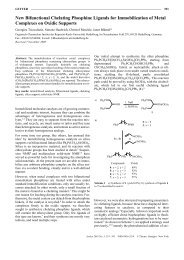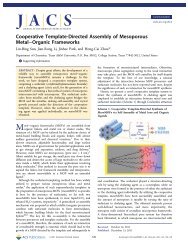Singlet Fission - Department of Chemistry
Singlet Fission - Department of Chemistry
Singlet Fission - Department of Chemistry
Create successful ePaper yourself
Turn your PDF publications into a flip-book with our unique Google optimized e-Paper software.
B Chemical Reviews, XXXX, Vol. xxx, No. xx Smith and Michl<br />
Millicent Smith received her B.A. in chemistry in 2002 from Tufts University.<br />
In 2007 she earned her Ph.D. in physical chemistry from Columbia<br />
University under the supervision <strong>of</strong> Pr<strong>of</strong>essor Louis Brus. Her graduate<br />
work included the synthesis and characterization <strong>of</strong> nanocrystalline barium<br />
titanate. She is currently a postdoctoral fellow in the group <strong>of</strong> Pr<strong>of</strong>essor<br />
Josef Michl at the University <strong>of</strong> Colorado at Boulder. Her current research<br />
focuses on the photophysics <strong>of</strong> singlet fission chromophores.<br />
A somewhat similar process, involving the successive<br />
emission <strong>of</strong> two longer-wavelength photons after excitation<br />
by absorption <strong>of</strong> a single higher-energy photon, is known<br />
for inorganic chromophores, especially rare earth ions, under<br />
the name quantum cutting. 3-5<br />
The multiple exciton generation process known in quantum<br />
dots <strong>of</strong> inorganic semiconductors and reviewed elsewhere<br />
in this thematic issue 6 may also have a related physical origin<br />
even though it occurs within a single but much larger<br />
“chromophore” in which singlet and triplet excitations have<br />
nearly identical energies and are not readily differentiated.<br />
This is particularly true in the presence <strong>of</strong> heavy elements<br />
and strong spin-orbit coupling, where the spin quantum<br />
number is not even approximately meaningful. In spite <strong>of</strong><br />
the obvious differences between singlet fission in organic<br />
materials and multiple exciton generation in quantum dots,<br />
certain features <strong>of</strong> the theoretical treatment <strong>of</strong> the former<br />
given in section 2 are related to one <strong>of</strong> the theories proposed<br />
for the latter. 7 Unlike singlet fission, multiple exciton<br />
generation in quantum dots inevitably faces stiff competition<br />
with conversion <strong>of</strong> electronic energy into vibrational energy<br />
followed by vibrational cooling.<br />
We review only the literature dealing with organic<br />
chromophores (singlet fission), from the time <strong>of</strong> the initial<br />
discovery <strong>of</strong> the phenomenon to the present day. An<br />
extensive review <strong>of</strong> the subject appeared in 1973, 1 and the<br />
most recent update we are aware <strong>of</strong> is found in a 1999 book<br />
chapter. 2<br />
1.1. <strong>Singlet</strong> <strong>Fission</strong><br />
<strong>Singlet</strong> fission is spin-allowed in the sense that the two<br />
resulting triplet excitations produced from an excited singlet<br />
Figure 1. <strong>Singlet</strong> fission: (1) The chromophore on the left<br />
undergoes an initial excitation to S1. (2) The excited chromophore<br />
shares its energy with the chromophore on the right, creating a T1<br />
state on each.<br />
are born coupled into a pure singlet state. <strong>Singlet</strong> fission can<br />
therefore be viewed as a special case <strong>of</strong> internal conversion<br />
(radiationless transition between two electronic states <strong>of</strong> equal<br />
multiplicity). Like many other internal conversion processes,<br />
it can be very fast, particularly in molecular crystals. There,<br />
when it is isoergic or slightly exoergic and the coupling is<br />
favorable, the transformation occurs on a ps or even sub-ps<br />
time scale, competing with vibrational relaxation and easily<br />
outcompeting prompt fluorescence. Only excimer formation<br />
and separation into positive and negative charge carriers<br />
appear to have the potential to be even faster under favorable<br />
circumstances.<br />
In the absence <strong>of</strong> any interaction between the two<br />
triplets, the singlet 1 (TT), triplet 3 (TT), and quintet 5 (TT)<br />
states that result from the nine substates originating in<br />
the three sublevels <strong>of</strong> each triplet would have the same<br />
energy. In reality, there will be some interaction and the<br />
1 (TT), 3 (TT), and 5 (TT) states will not be exactly degenerate.<br />
As long as they are at least approximately degenerate,<br />
they will be mixed significantly by small spin-dependent<br />
terms in the Hamiltonian, familiar from electron paramagnetic<br />
resonance spectroscopy (EPR). In organic molecules<br />
that do not contain heavy atoms, these terms are<br />
primarily the spin dipole-dipole interaction, responsible<br />
for the EPR zero-field splitting, and the Zeeman interaction<br />
if an outside magnetic field is present. Hyperfine interaction<br />
with nuclear magnetic moments, responsible for the<br />
fine structure in EPR spectra, is also present but is weaker.<br />
In molecular crystals, where triplet excitons are mobile,<br />
its effect averages to zero if exciton hopping is fast on<br />
the EPR time scale. Spin-orbit coupling is present as well,<br />
but in molecules without heavy atoms it is weak and is<br />
normally negligible relative to the spin dipole-dipole and<br />
Zeeman interactions.<br />
The nine eigenstates <strong>of</strong> the spin Hamiltonian are not <strong>of</strong><br />
pure spin multiplicity. The wave function <strong>of</strong> the initially<br />
formed pure singlet state 1 (TT) is a coherent superposition<br />
<strong>of</strong> the wave functions <strong>of</strong> these nine sublevels, and their<br />
ultimate population will reflect the amplitude <strong>of</strong> the singlet<br />
1 (TT) wave function in each one. As long as the states<br />
resulting from singlet fission are <strong>of</strong> mixed multiplicity, the<br />
overall process can also be viewed as a special case <strong>of</strong><br />
intersystem crossing (radiationless transition between two<br />
electronic states <strong>of</strong> different multiplicities).<br />
There is an interesting difference between intersystem<br />
crossing induced by singlet fission, primarily as a result<br />
<strong>of</strong> the existence <strong>of</strong> spin dipole-dipole interaction, and<br />
the much more common intersystem crossing induced by<br />
spin-orbit coupling. Unlike the spin-orbit coupling<br />
operator, which connects singlets only with triplets, the<br />
spin dipole-dipole interaction is a tensor operator <strong>of</strong> rank<br />
two, and it has nonvanishing matrix elements between<br />
singlets and triplets, as well as between singlets and<br />
quintets. Therefore, singlet fission has the potential for<br />
converting singlets into both triplets and quintets efficiently,<br />
thus expanding the Jablonski diagram as shown<br />
in red in Figure 2. Excited quintet states <strong>of</strong> organic<br />
chromophores with a closed-shell ground state have never<br />
been observed to our knowledge. In the singlet fission<br />
literature they are usually dismissed as too high in energy,<br />
but this need not be always justified.<br />
Why is it, then, that singlet fission has remained relatively<br />
obscure, and all textbooks and monographs dealing with<br />
organic molecular photophysics show a version <strong>of</strong> the


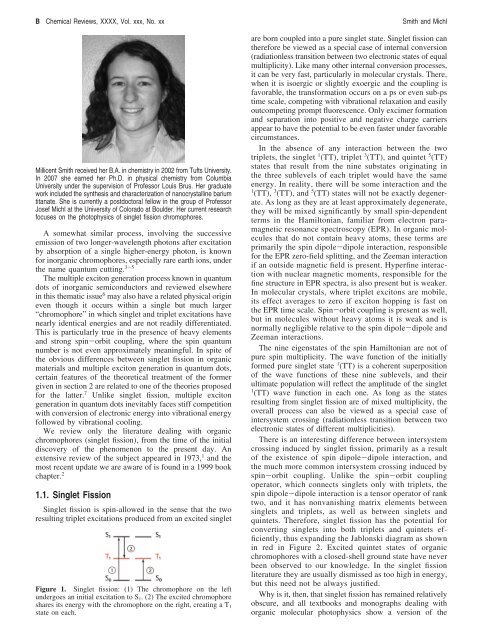
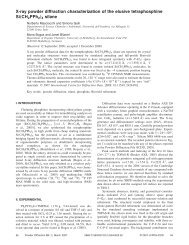
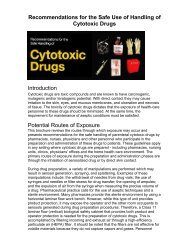
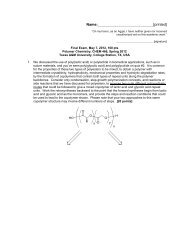

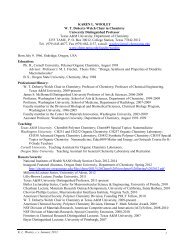
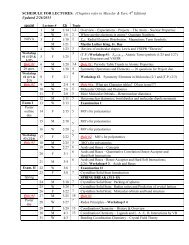
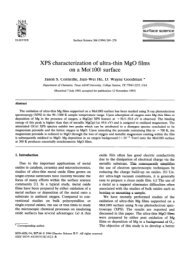
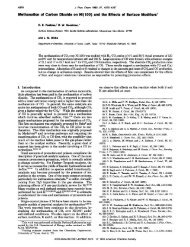
![Radical salts of TTF derivatives with the metal–metal bonded [Re2Cl8]](https://img.yumpu.com/10115211/1/190x253/radical-salts-of-ttf-derivatives-with-the-metal-metal-bonded-re2cl8.jpg?quality=85)



